
I was having a chat with a friend the other day about free will, and the simulation hypothesis, and at the end he said something to the effect of, “Well, that makes sense, but even if so I don’t know how that changes anything. I’d live my life the same way.”
Ehhhh…
Knowing always changes things, but it’s difficult if not impossible to know exactly how knowing will change things for *you*. You could become a Morpheus…or you could end up like Cypher 😂
I’ve been thinking for a long time though about the potential natures of reality, and what each might mean, so I wanted to put together a post exploring some of the many possibilities, and how knowing the answer to “What is the nature of reality?” could actually change everything.
To do this, we need to explore a few things (in no particular order): simulation theory, quantum physics, Everett’s Many Worlds hypothesis, The Mandela Effect (a fantastic movie by the way), game design, philosophy, consciousness, materialism, non-duality, panpsychism, religion, the idea of a creator, cause and effect, free will, and a few more things besides.
Whew 😁
Of course, while all of these “reality models” are fascinating in various ways, and one of them could well be true, some are not (as David Deutsch would say) good explanatory theories, because it may not be possible to disprove them.
I think that’s actually OK ¯\_(ツ)_/¯
Our ability to prove or disprove something with our current knowledge or technology should never result in discarding a potentially true explanation…but nor should we state as true something that can’t be adequately tested and verified.
Also, I think it’s important to make the distinction that the word “real” (and “reality” along with it) can apply to virtual, digital things. David Chalmers explains this well in his book Reality+, which I highly recommend.
Anywho 😁
Here goes!
First, as I’ve discussed at least partially here and here and here, I think it’s likely that the true nature of reality is NOT what most think it is.
As to precisely what that nature is, I think there are a handful of key possibilities, or Reality Models, to look at:
- We’re in a simulation (specifically a “set the starting conditions and system rules and see how it plays out” type simulation, though there are a LOT of sub-possibilities here)
- We’re in a video game (maybe NPCs, maybe PCs)
- We’re in a training program (maybe AIs, maybe real live trainees)
- We’re a mental construct in the “mind” of something (non-duality, Advaita, Zen; I think this could be a misinterpretation or semantics regarding #1-#3)
- We’re real material beings created by a “deity” (Theism, though I think this is just a misinterpreted offshoot of #4)
- We’re real material beings, but a product of purely natural forces (Atheism, Science)
- We’re some sort of hologram/illusion/afterimage (Holographic Universe Theory)
Looking at all of these in aggregate, it appears that in some way, shape, or form, we were either created by some sort of higher intelligence, or we were not.
This could be a false dichotomy, accounting for unknown unknowns, but this is what we have to work with today.
Reality Models #5-#7 deal with flavors of Realism and Materialism (the idea that matter is fundamental), while #1-#4 deal with Idealism (or perhaps what I would call Level-Upism, the idea that we are in some sort of construct or system, and that real reality is at least one level up from what we’re experiencing; that we are not in base reality). Though to be fair, #7 could actually be interpreted in such a way as to work for either Realism or Idealism…fun times.
And the creator debate is actually where I think religious folks (and frankly atheists as well) get hung up, conflating the idea of a creator in some fashion with all the other religious twaddle they’ve been taught. Too many things unnecessarily conjoined.
It IS possible to both have a creator, and for that creator and the nature of our reality to in no way be like the god or theistic doctrine you’ve been taught about in Sunday school.
Am I being harsh towards religion? Yes. And for good reason, which I’ll cover more a bit further on. Organized religion may have been useful (debatable), despite being at least mostly false (provable), but that’s a post for another time.
For now let’s keep moving, starting with Reality Model #7, and moving from least likely to most likely.
#7 – Hologram, Illusion, or Afterimage
First, it might not be fair to bundle all these into one bucket, the afterimage bit in particular. There are actually quite a few flavors in this conceptual basket of ideas, some of which may be more viable than others.
The short and skinny here though is that what we think of as a 3D universe may in fact be a projection originating from 2D information, much like what we’d see on a TV screen.
On the one hand, I think this could actually sync up with the idea that we’re in a virtual reality of some kind (game, simulation, etc.), which we’ll explore in a bit. It effectively says that none of what we think of as “real” is actually real in the traditional material sense, which appears valid.
On the other hand, if everything we think of as real is just an afterimage left behind after the big bang or following contraction…that’s just fucking weird. Maybe it’s just me, but I find this the strangest of all of these ideas.
I might be cutting corners here, but I’m going to table #7 for the time being in part because I don’t think it’s possible to test, prove, or disprove at present (the only proposed test I’ve heard of wouldn’t prove or disprove this theory, it would simply disprove some other theories), and in part because I have yet to fully wrap my head around all the possibilities in the space.
Withholding final judgment while awaiting further evidence.
If you want to go deeper down this rabbit hole, go for it, but I think there are already much more interesting, viable, testable hypotheses.
Moving along.
#6 – Material Beings, Natural Forces

I love science, and the process of posing a question, forming a hypothesis, gathering data and testing the hypothesis, and only accepting it as (seemingly, conditionally) true when data supports it AND fails to disprove it, is a fantastic approach.
We’ve made enormous advances thanks to science, and I think we should, and most likely will, continue making such advances unabated. Maybe.
BUT, there is a point (perhaps many) beyond which science can’t yet play, and that is the realm of unknown unknowns. And on top of that, there are many times many known unknowns science has yet to grapple with, just one of which is the Big Bang (physicists do not agree on what, if anything, occurred before).
The problem here is, no matter how you slice it, we’re forced to contend with Aristotle’s Unmoved Mover concept.
What happened before the Big Bang? Anything?
We just don’t know. If we live in a causal universe, the answer can’t be nothing. And if the answer is something, then what? What came before that? Was our “Big Bang” just the latest cycle of the Big Bounce? If so, what started the bouncing?
If we live in a causal universe, then no matter how you slice it you end up with a problem: Infinite Regress.
Now perhaps, as seemingly finite beings, this interpretation is just a human misunderstanding. We appear to exist in time, though time may not actually be a real (material) thing (again, physicists are undecided). But could there really be no beginning and no end? Could there be a beginning but no end? No beginning but an end?
I mean, we appear to exist in 3 dimensions (maybe 4 if Time counts as a dimension), and our brains aren’t really capable of handling dimensions higher than that. And if string theory or M-theory are correct, there could be 10+ dimensions to our reality.
And of course, our senses process only a tiny fraction of a fraction of the electromagnetic spectrum alone (something like 0.0035%), so we are “seeing” the tiniest fraction of “reality” anyway.
And what we do process is massively warped and contorted by our brains, in an absurd number of ways.
🤯
This could be a true model of reality, but if so we can’t yet prove it, and there’s a growing body of evidence that seems to indicate otherwise.
If #6 were accurate, what would it mean?
That atheists and traditional scientists are correct, that there is no creator, that reality is material, that everything can be explained by natural laws and statistical chance. That with time and effort we can explore and understand and explain everything.
That religion and spirituality are just feel-good bullshit created by greedy and power hungry men.
That when we die, that’s it, we cease to exist and there’s nothing more.
Frankly, though this terrifies most folks, I’m perfectly fine with this outcome. If I cease to exist when I die, oh darn. ¯\_(ツ)_/¯
Good reason to enjoy life and treat your time as precious.
Can this be tested?
Of course, with time, exploration, experimentation, technical advances, additional data, etc. Assuming we don’t get obliterated by some natural phenomena (or ourselves) before we figure it out.
And frankly, the same goes for #1-#5, all of which we may be able to test and prove eventually…though there may be some theories that aren’t actually *disprovable*.
But, while I leave this in the “possible” bucket, the latest findings in quantum physics (entanglement, observer effect, quantum tunneling, and the delayed choice eraser experiments in particular) make me think that this is not actually the case, and we’ll explore these more shortly.
#5 – Material Beings, Created by “Deity”

I’m putting Deity in quotes here for two reasons.
One, because I strongly suspect the idea of a theistic daddy god or a pantheon of gods is in fact just a misinterpretation of the idea that we exist in the mind of some universal consciousness, which is the premise of #4 (and one of the oldest and most common ideas throughout history).
And two, because what appears god-like to us could just be a more advanced being, an alien of some sort, and not a supernatural god in the traditional theistic sense.
The common monotheistic interpretation of Abrahamic religions (Judaism, Islam, Christianity) I believe we can discard using a bit of simple logic and those religion’s own texts. If you want to go down this rabbit hole, I recommend starting with Bible Inconsistencies, these criticisms of the Quaran, and these logical arguments against the existence of god, and then go from there.
I’ll make it simple: list off the attributes your belief system attributes to God/Allah (omnipotent, omniscient, omnipresent, loving, just, judgmental, etc. etc.), and then ask yourself if the things that your God has provided (scriptures, religions, religious leadership, etc.) and the things that God has supposedly done/will do (creation, judgment, punishment, citing specific scriptural references) are self-consistent within those texts, AND consistent with your God’s attributes.
If you can set your cognitive dissonance aside, the answer you arrive at is going be a categorical NO. I’ve done this, carefully (my minor was religion, particularly comparative religion).
Monotheism is decidedly inconsistent, in many times many ways, and that inconsistency is incompatible with the attributes attributed to the god of Abraham.
Sorry not sorry.
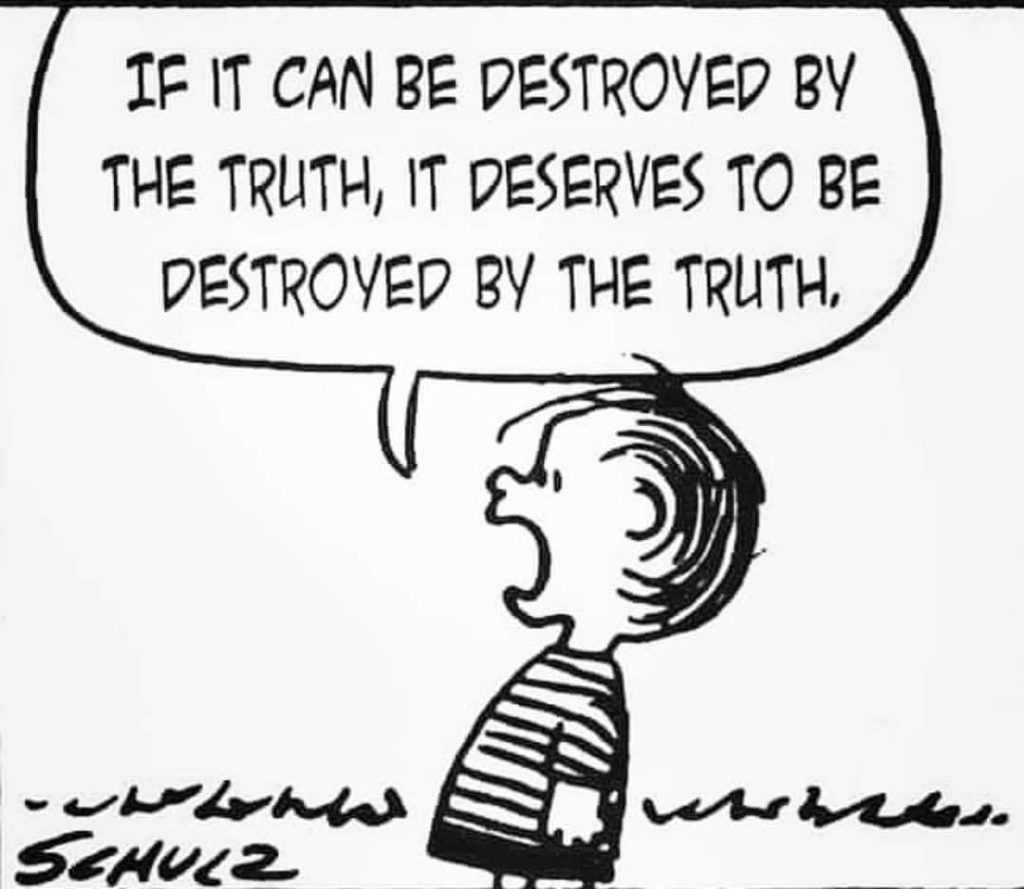
If that comes as a kick in the sack, oh well. You could throw a rock and hit more than enough info to handily disprove Christianity, Judaism, Islam, or any other flavor of monotheism.
Of course, deity could also mean some advanced alien creator within our universe, not a god in the religious sense, but perhaps an alien scientist from a radically advanced society.
Just because humans have anthropomorphized the image and idea of God doesn’t mean that’s the only possibility here.
Panspermia is an interesting line of thought, as is some other flavor of direct alien intervention or experimentation.
For all we know we’re some alien kid’s high school science experiment, or an ornament around their pet cat’s neck 😂
There are a lot of potential interpretations to deity, and the repercussions from that could range from none whatsoever, to Earth shattering.
If #5 were accurate, what would it mean?
How this would impact us, collectively or individually, would depend on the specifics. There are a lot of sub-possibilities in this bucket, and I can’t explore all of them here (hell, many are unknown unknowns I can’t even fathom).
If you could in any way prove or disprove the core components of the traditional theistic religious stance, Pascal’s Wager would come into play (even though it’s otherwise “god” awful logic lol), which would necessarily change your approach to the game of life.
If we could prove we’re some sort of alien creation/experiment, that would at least answer the question “Are we alone in the Universe?” which I imagine could unify us as humans of Earth, and perhaps change our goals moving forward. Star Trek anyone? Sign Beam me up!
Can this be tested?
With time and additional data and technological advancements and vast exploration, maybe. Depends on the specifics. If a deity/advanced being/alien species is deliberately limiting what information we have access to, we could very well be prevented from testing or proving/disproving anything.
What you can do though is examine traditional religions carefully, and discard anything that proves to be false. If you follow that thread, as I have done extensively, what you’ll arrive at is our next possibility.
— Here we leave traditional realism/materialism behind, and explore the various artificial/externally created possibilities. —
#4 – Mental Constructs in the “Mind” of Something

The idea of Nondualism/Non-Duality, which can be found explicitly in many flavors of various belief systems such as Buddhism, Hinduism, Sufism, Sikhism, Gnosticism, etc., (and light-to-moderately hidden in religions such as Islam, Christianity and Judaism) states that our reality is a mental construct, and that each of us is just an aspect of some overarching universal consciousness.
It’s tied to Panpsychism, the idea that everything is conscious, which I think is often misinterpreted to mean that each and every thing has its own individual consciousness…that is not what this means. It isn’t (or shouldn’t be) saying every rock and twig and particle has an individual conscious identity, but that everything in our reality exists within the consciousness that created it.
That consciousness is fundamental.
This is the premise of Analytic Idealism, which is itself a fascinating rabbit hole to explore. Google Bernardo Kastrup is you want to explore 🙂
Of course, the very word consciousness is a human construct, meant to differentiate our experience and make us seem special/superior to everything else, and there is no single accepted definition or measure of consciousness.
Since we haven’t clearly defined it, we don’t even know if we all have it, we can’t (yet) test it, we don’t know if anything else has it…fun times.
The closest we can get here is Solipsism, the lived experience of being an individual, having experiences (qualia), and being able to think about those experiences, and that sense of “I-ness” is all we can truly know for sure…and even then we can’t be certain that perceived experience isn’t something akin to an optical illusion, a misinterpretation due to our brain taking shortcuts.
If you dig into this space it becomes crystal clear that the shared root is the idea of a (most likely singular) conscious being, of some sort, that has created our entire Universe in it’s mind, for some reason (loneliness, curiosity, boredom, challenge, who knows). The reasons vary, and the nature of the being varies, and whether it’s done by one being or more varies (single player vs. multiplayer?), but the root idea—it’s all a mental construct, and none of this is “real”—is consistent.
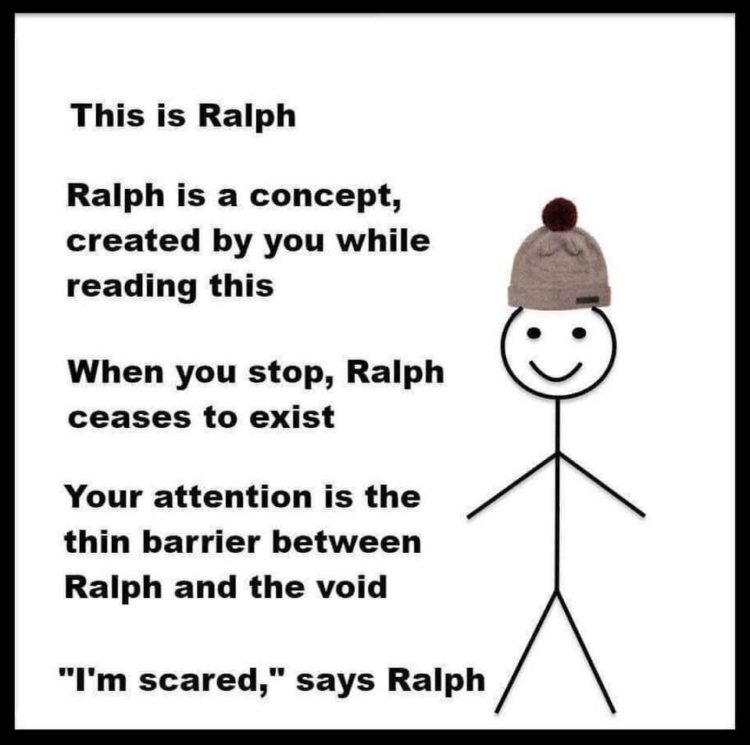
If you want to begin exploring these ideas, I highly recommend this blog post, and these books as starting points.
This concept, I think, is a very real possibility.
I’ve found these threads, consistently, across every major and most minor religions, philosophies, and mythologies I’ve examined, spanning all of recorded history.
The concepts aren’t always clearly expressed, and are often buried in superfluous bullshit, but they ARE there.
Hell, the oldest known human culture, that of the Australian Aborigines, refers to our reality as “The Dreamtime” or “The Dreaming” (and this idea goes back ~65,000 years).
We could in fact be in a dream of some sort, just another flavor of mental construct.
While not a scientific experiment, I’ve found that everything we think we know, and everything we can observe, fits neatly within the mental model of *this* (waves hands) existing in the mind of some sort of “conscious” entity.
It’s a key that fits every lock I’ve tried it on.
If #4 were accurate, what would it mean?
It would mean that there are no individuals (individuality is just an illusion), that none of this is real in a material sense, that there is no free will (the universal consciousness is the one choosing, while the you you think of as you doesn’t actually exist), that none of this actually matters existentially speaking, and quite possibly that everything is predetermined (though not necessarily, depending on the way the universal consciousness is creating this universe…it could very well be playing a CYOA game, or surfing the chaos).
It could also very well be playing hide and seek with itself, and therefore knows what comes next no more than we do. Scott Adams’ book God’s Debris explores this in a very interesting way.
It would mean that whatever is, is permissible. That anything you can do is acceptable, and perhaps even as planned. It could mean that there is no such thing as right and wrong, no such thing as morality, no such thing as, well, anything.
All figments of a grand imagination.
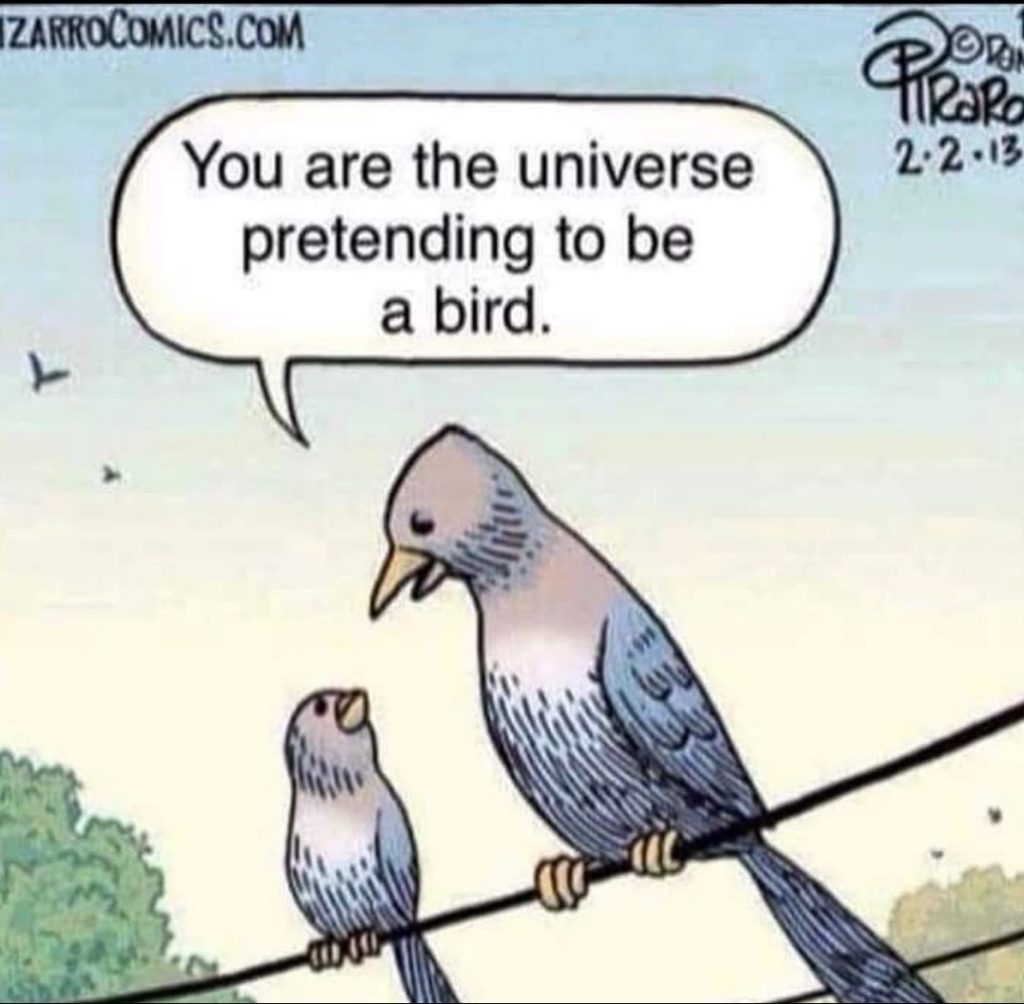
Can this be tested?
Possibly, though perhaps not in a scalable, easily replicable way. There is this idea of spiritual autolysis, a process of examining and discarding everything you believe, piece by piece, that supposedly leads to enlightenment, a state where you recall your true identity as universal consciousness and no longer identify with anything in this reality (think Buddha, or maybe Jesus).
But it’s a solo path, and I can think of no way to actually verify this other than personally (and that’s not scientific at all, unless the process is perfectly replicable by everyone who follows it, which it may or may not be).
Granted, that process may just trigger a dissociative or schizo affective disorder…so be careful.
If you have ideas on how this could be tested though, I’d love to hear them!
That said, just as I think monotheism is a misunderstanding of the concept of non-duality, I still think there’s a very real possibility that non-duality is itself a primitive misunderstanding stemming from insufficient knowledge and data.
Without knowing what a computer, video game, or simulation is, the closest thing you’d have to model from would be humans themselves (a human-like god, anthropomorphized super consciousness, whatever), which is exactly what we see in the explanations of the various ancient non-dual systems of thought.
Plato’s Allegory of the Cave is the earliest attempt I know of to explain something like this, a Matrix-esque exploration of the illusory nature of “reality”:
Which brings us to #1-#3, which I believe are actually the most consistent with what we’re seeing in quantum physics 😉
<Quantum Interlude>
Before we go further, I need to introduce you to a few ideas from quantum physics, with the caveat that I’m not a physicist, so if I get any of this wrong please correct me!
These are going to help explain why I think these last 3 possibilities (those involving some form of virtual reality) are the most likely of all.
Quantum Entanglement
Here’s a YouTube video that explains this (or skip the vid and keep reading):
It is possible for two particles to become entangled, which for all intents and purposes means in-sync. If you have two entangled particles, and measure the state of one entangled particle, the other particle’s state updates in-sync based on your measurement instantaneously, regardless of the distance between the particles. While not required, it is also possible for identical particles to become entangled.
This would *appear* to violate the speed of light, because that state-change (information) is traversing space instantly, taking no time…but then again, our measurement does take time, so we can’t be certain this is the case.
Physicists are still arguing about this, whether it’s possible, whether this interpretation is correct. Since we lack the ability to measure or observe at or beyond the speed of light, this may not actually be disprovable.
Entanglement is at least highly replicable, so there’s that…
In a material universe that obeys the laws of classical physics, what we’re seeing with quantum entanglement shouldn’t be possible. And perhaps that’s why nobody has successfully unified classical and quantum physics!
However, if we’re in some sort of training program, game, or simulation (a virtual reality), then there are actually 2 aspects to consider: in-game reality, and base reality.
In a game, every object that exists in the game world has a Unique Identifier that pulls that object’s coded properties into the rendered game. For example, if you have a sword in your game, you can place copies of that sword in various spots in the game world, but if you change the root GameObject information for that sword (size, texture, material, etc.) and push an update, it will change the state of all instances of that GameObject everywhere it has been placed simultaneously. They are more or less entangled objects.
If you did this while players were observing each of these swords, to the observers in the game the changes to the swords would appear instantaneous regardless of perceived distance.
Identical quantum entangled particles in particular, I believe, could be showing this behavior.
As observers inside the system, we perceive time and space, and things may seem far apart or close together, and the physics of our world set rules and limits that GameObjects generally adhere to. But those distances and rules are illusory, just bits of code in a system, and in the game base code and the computing system running it, they are effectively in the same place in base reality, a level above us.
We perceive Alpha Centauri as 4.37 light years away from Earth, but in the game code, that “distance” is nothing but variables in a database, and moving an object from one location to another requires nothing more than changing the GameObject’s location variable.
We think, because we perceive time and space, that information moving across a vast distance should take time, and be limited by the speed of light (because perhaps that’s how our physics engine works, and that’s normally the case for us), but those are internal constraints imposed by our rendering and physics engines, and not applicable “outside.”
And of course, for anything moving at the speed of light, basically no perceived time passes regardless of distance.
My hunch is that classical physics represents the physics engine of our rendered reality, while quantum physics is us bumping up against the underlying code of the system in which we exist.
If so, there will be no unification of classical and quantum physics.
Quantum Tunneling
At the apparent “material” level of reality we deal with everyday, the laws of classical physics apply consistently. For example, the law of conservation of momentum constrains the range of where a physical object can be, based on its starting conditions.
Particles, which operate according to quantum physics, are under no such restrictions. As such, even though it’s improbable, a particle can end up in places that classical physics says are statistically possible, no matter how unlikely.
Again, as with quantum entanglement and their apparently impossible method of sharing information, these are limits that make sense in a purely material world. But if we’re inside a computer program, these anomalies become much easier to explain. Any GameObject can have it’s locationID changed at any time for any reason by forces in base reality.
The Observer Effect
Now here’s where things really begin to get spooky, as Einstein would say. What we term “The Observer Effect” (also known as Quantum Indeterminacy) comes from an experiment known as the Double-Slit Experiment:
There was once a debate in physics: Is a photon a particle, or a wave?
The answer turns out to be both…until observed. Only once observed (causing the collapse of the wave function) does a photon resolve into a particle.
If one or both of the slits are monitored, the photons behave like particles the entire time; going through one slit or the other, and forming 2 clear dots or lines to represent the two slits (exactly what you would expect in a material world if you were doing this with large slits and paintballs).
But if you don’t monitor the slits, and even if you do this experiment with one photon at at time, you STILL end up with an interference pattern (many lines behind the 2 slits) as if those single photons were running into *something that isn’t there*, which is NOT what you would expect in a material, causal world.
What this means, in essence, is that outside observation takes a photon from a probabilistic state to a fixed state. Or so it appears.
Reality seems to change when observed…the simple act of your observing a photon changes its state 🤯
There are multiple interpretations of what this means and why things might be this way, ranging from the Copenhagen Interpretation, to Quantum Field Theory, to Everett’s Many Worlds Interpretation.
The short and skinny though is that we just can’t be sure.
For now.
There are experiments being done now to determine what specifically counts as an observer (human, device, animal, etc.), and there have been experiments performed that seem to indicate that the observed state-change is fixed ONLY for that specific observer…that reality is “rendering” for each individual.
There are even experiments being performed in this area to determine if we’re in a simulation 😉
Here’s why I think this is SUPER interesting:
In video games, you have something called procedural generation. Essentially, to save on processing power, only the things currently visible to the player are rendered, and only to the depth of their observation, and only up to certain system limits (in a game that would mean resolution/pixel size, render distance, frame rate, etc…but to us that might be the speed of light (render distance), resolution/pixel size (Planck length), etc.).
Some pre-rendering of things just outside the player’s view may occur (which could explain why a probability wave needs to exist), but in a sufficiently advanced system capable of instantaneous real-time rendering that might not be necessary. Some aspects of the game may be fixed, scripted, while other aspects may be totally random.
Procedural generation, stated simply: “Everything in the game is in an unrendered, probabilistic state until observed by a player.”
Sound familiar?
The program knows where every previously observed/expected GameObject is, even when unrendered, and the properties of those objects, and the rules of the game world, but it spends no resources rendering those things unless a player (observer) needs them rendered.
However, once a specific player observes something in a specific state, that new collapsed waveform state is stored in the system tied to that player’s characterID, so that player has a consistent experience going forward.
The argument that we can’t be in a computer program because a computer would need to be bigger than the Universe to render the Universe is therefore false, because with procedural generation the system never actually needs to render the entire Universe…only the observed bits, and only to the depth observed, and only by those currently observing it.
Considering how fast our own game engines are advancing, this makes perfect sense to me. Give this a watch 🙂
The Delayed Choice Eraser Experiment
Now, the last piece of this quantum puzzle I want to look at is a complex variation of the classic observer effect “double slit” experiment known as the Delayed Choice Quantum Eraser.
In effect, physicists found a way to split, entangle, and observe particles AFTER they have gone through one of the double-slits, but in a way that varies the timing of the particles and the observation…you’ll have to watch the video, there’s a LOT to this.
However, the summary is this: when and where the particle is observed can retroactively change which slit it went through, and whether it behaved as a particle or a wave.
Future observation seems to have changed PAST behavior.
Yes, we’re talking about retrocausality.
Time Travel.
Maybe.
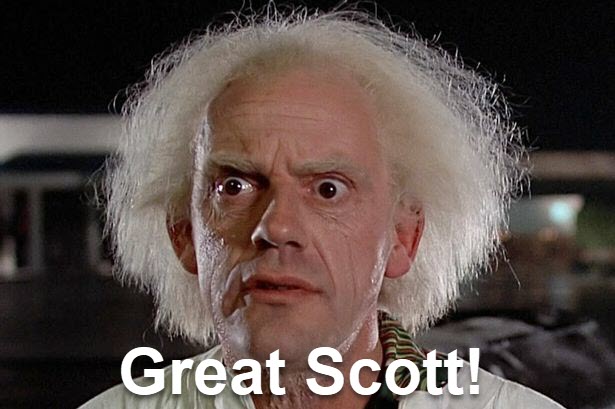
Again, physicists are debating this interpretation furiously, but this experiment is as consistently replicable as the original double-slit, and the principles are sound, soooo…
To be fair though, physicists aren’t sure that time even exists, so maybe this isn’t as strange as it seems.
But, here’s the twist. In a game, the “past” is nothing but a save state. You can save your game at any point, many times, and when you load up one of those saves you go back to a previous time.
If game developers were to decide to change something in the game at a future date, they *could* push that change out in a way that updates save states, in essence using a future change to affect the past.
Whatever it is we are in almost certainly has an error-correction system, most likely automated, and if action X in the future necessitates an update to past-states, those past states are updated accordingly.
Of course, when updates are made, sometimes there are unintended consequences, and sometimes the update doesn’t actually reach everywhere it was supposed to.
Perhaps that’s one possible explanation for The Mandela Effect (and yes, false memory is a very valid possibility for this as well, as is human error).
The point being though, if we are in a game, the idea of a future action affecting a past state isn’t actually unusual at all. It’s routine.
And as you can see, all of these facets of quantum physics strongly indicate that we do not in fact live in the material, causal universe that we seem to think we do…in fact, they very much indicate that we exist in a virtual reality of some sort, and so we continue down our rabbit hole 😁
</Quantum Interlude>
Now that you have a semi-decent understanding of these 4 elements of quantum physics, let’s explore the “nature of reality” possibilities #1-#3, continuing in reverse order.
#3 – We’re in a Training Program

A human child goes through many years of teaching, training, and social/religious indoctrination to prepare them to exist within their society/tribe, to learn the “rules of the game” so to speak. You go through additional training for specific vocations. More training to build new skills, hobbies, or to correct problems (therapy for example).
In the movie The Matrix, Neo and the other humans can use their neurocannular ports to load training directly into their brain…
What if that’s what we’re doing right now?
In a game, the game time can run at a different pace from real world time. When you take DMT (an incredibly powerful psychedelic), you can experience something that feels like hours, days, or in some rare cases even a lifetime or longer, but the actual experience only lasts 5-20 minutes in our reality (something akin to time dilation).
Is it such a stretch to say that an advanced species, in order to train their young, puts them through a realistic VR program where they live what feels like many different lifetimes (reincarnation?) in order to learn certain lessons and traits, but in their base reality each lifetime experienced only takes a few minutes?
Perhaps after each life “lived” they are assessed, and any trouble areas are programmed into their next “life” so they can work on it?
Maybe some trainees are quick, and only need a virtual lifetime or two to achieve mastery of the necessary skills, while others just don’t get it and go through dozens or hundreds of iterations.
This also fits handily with the religious idea that we are here to be tested, and that how we live our lives affects what happens after.
Hmmm.
My Twitter buddy Tinkered Thinker has a great Lucilius Parable that explores this concept and is definitely worth a read.
If #3 were accurate, what would it mean?
For starters, it would mean that this is a computer program of some sort, a virtual reality, and that none of this is real. It would mean that, assuming you are the trainee, that the real “you” exists a layer up in reality (though you could just as easily be an AI NPC with a role to play in the training program, or this could be an AI training program with no living players at all).
It would also probably mean that, if you ARE a trainee (and IF that means you exist in a “real” world outside this one and aren’t just an AI) and you die in here, you probably just go back to your real world, and the only thing that ceases to exist is the character you were playing in here.
It would also likely mean that, being in a program, there are some rules and constraints. There would be hardware and software limitations. But it would also mean, being a training program, that we likely have free will in some fashion (maybe not entirely unencumbered, but the ability to make at least some conscious choices).
Free will isn’t a necessity though, since you can be trained to follow instructions, and no choices of your own are necessary if just stick to the script. Depends on what sort of training program this is.
It would also mean however that we’re in here for a purpose, trying to learn something or many things, and any training program would almost certainly have clues or guiderails of some sort to nudge you along and help you make key decisions and learn key lessons.
Perhaps that could explain things like Deja Vu, Synchronicities, recurring experiences or patterns, unusual thoughts or promptings to do something, not do something, go somewhere, etc.
It brings up the idea of Player Characters (PCs) and Non-Player Characters (NPCs). In a game or VR program, there can be real players (someone in base reality who enters and plays the game) as well as virtual characters who play parts in the program (NPCs).
If this is a training program, the question is, who in here is a trainee/player character? Is this a single player training program? Multiplayer? Massively multiplayer? Are there NPCs? Can you identify which is which?
In this scenario, the optimal path would likely be to A. assume you are a PC, B. try to watch for clues to guide your choices, and C. try to learn everything you can, exploring your mind and feelings and experiences deeply. It would also most likely be optimal to drop any fear of death, though simultaneously not to purse an early demise (you want the training program to run its natural course).
Without knowing what sort of training program this is, and the purpose of it, you would be guessing though.
Can this be tested?
Specifically, from inside the training program, maybe. I’m not sure we could make the distinction that it’s a training program, but we can maybe test to see if our reality is virtual in some fashion by trying to mess with the procedural generation system, seeing if we could push the rendering engine too hard and generate glitches.
But if it’s possible to somehow tap directly into the program code, and if we could interpret it to learn the nature of the system…but I imagine a training program would be monitored, manually or in an automated fashion, and surely cracking into the program code would trigger some sort of intervention…unless doing so is a part of the training.
We should try though and see what happens!
Food for thought.
#2 – We’re in a Video Game
As weird as this one may sound, as a lifelong gamer who is obsessed with solving puzzles, there’s a decidedly biased part of me that thinks this is actually the most likely scenario 😂
This clip from the cartoon Rick and Morty does a neat job of showcasing this idea:
Looking at the advancements we’re making in the world of games, virtual reality, brain computer interfaces, processors, graphics cards, storage, etc., we can clearly see an exponential trendline forming (make sure you watch that Unreal Engine 5 video).
As such, it isn’t a stretch to imagine that in the not too distant future we’ll have technology capable of generating a virtual world that is indistinguishable from this one, and if we can do that, who is to say an intelligent species hasn’t already done this and we’re in the VR world they built? (This is Nick Bostrom’s argument.)
Just as with the training program scenario though, games tend to have both Player Characters (PCs) and Non-Player Characters (NPCs), and a game such as this wouldn’t likely be any different…and if you look around at some of the idiots in the world, it’s not hard to believe there are a LOT of NPCs out there 🤣
There’s another good Tinkered Thinking blog post that explores this here: Endless Entertainment
In this light, fear of death could vanish, and suicide could even be seen as an exit command. ¯\_(ツ)_/¯

If #2 were accurate, what would it mean?
That would depend on if you’re a PC or an NPC, and on the nature of the game itself.
Some games are highly scripted, containing few if any real choices, more akin to watching a movie than anything. Performance art.
Other games are massively open world, offering almost unlimited options, with no more than a handful of guiderails.
What you could do in here would depend on answers to those questions. And on whether this game has bugs, as most do…
If you’re an NPC, then you have no free will and operate strictly according to your programming.
If you’re a PC, then perhaps you do have free will, and can choose what you do and don’t do in the game.
BUT, if we knew for certain this was just a game, then a LOT changes. It could completely change your playstyle, could wipe out fear, embolden you to do things you wouldn’t otherwise do.
It would mean nothing in here matters…it’s just a game after all, a transient experience meant to entertain. Why take anything at all seriously?
Any serious gamer first explores and seeks to understand the parameters of the game, and then experiments and explores and pushes the limits to see what can and can’t be done.
As Morpheus would say:
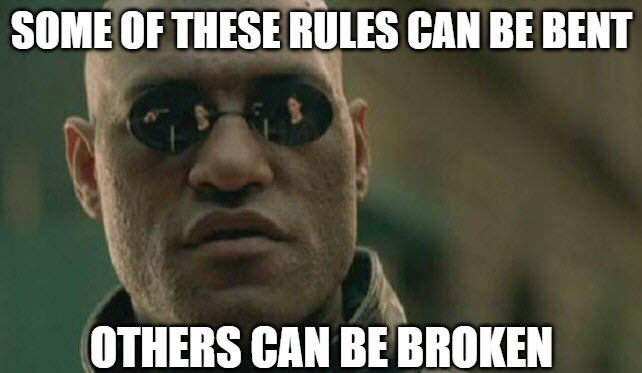
Gamers aren’t usually big on following rules, lol.
Can this be tested?
As with #3, we might be able to determine that we’re for sure in a virtual world, but I’m not sure we could narrow it down any further without finding a way to directly access the underlying game code.
That said, I think I’ve yet to encounter a game designer or developer who doesn’t build a backdoor or admin functionality, create a cheat code, or hide some sort of Easter egg in their work, so there’s a decent chance we could find *something* to indicate this is a game if we poke around long enough.
And of course, there are the aforementioned bugs that every game seems to have (some more than others…cough, Cyberpunk 2077, cough…) 😁
Deja Vu? Mandela Effect? Could those be game glitches?
I’ve never encountered a game that didn’t have bugs, glitches, things you could do that weren’t anticipated, and I’d be awfully surprised if whatever we’re in doesn’t have something similar.
And, drumroll, last but far from least…
#1 – We’re in a Simulation
This is a fantastic video covering the simulation hypothesis, and looks at some of the game elements as well:
The simulation hypothesis is of course a bit of a catchall, and while some people might lump game or training program into the simulation bucket, and while there are certainly some technical similarities, I think simulations deserve there own clear distinction.
First, if you aren’t familiar with this, it’s rooted in the idea that future humans, for various reasons, might want to simulate past versions of their history/reality. Maybe to see how changing certain variables would change the outcome. Maybe just to observe how things might have played out long before recorded history.
Who knows, lots of maybes.
However, here we need to make a few distinctions clear in regards to simulation types:
- Training Simulation
- Simulation Game
- Testing/Observation Simulation
- Prison Simulation (a la The Matrix, a sort of mind prison meant to hold and occupy intelligences)
There are probably others I’m not thinking of, but these seem like the most realistic buckets.
We’ve already covered training and games in previous sections, so we can skip those here. This is why I think there’s some semantic overlap with the idea of a simulation and some of the other possibilities I think should be examined distinctly.
In a Testing/Observation simulation, you would have a set of rules (physics?) and a specific set of starting conditions (Big Bang?) and you would then run the sim to see how things played out.
In theory, in a closed, non-random system with fixed rules and identical starting conditions, you should be able to run the sim over and over again and get exactly the same results each time. And if you change something, even something small, you could get a wildly different outcome (the Butterfly Effect).
Same thing if you introduced randomness.
Why would you create a sim like this? So you could test assumptions, and so you could tweak certain variables (rules and/or starting conditions) to see how things played out.
Perhaps a future civilization on the brink of collapse, which develops time travel and wants to change their fate, needs to run simulations to see exactly which variable needs to be changed to have the desired outcome?
Or perhaps some future university students are working on an advanced quantum VR simulation of Earth’s history.
Or a million other possible reasons.
You could also theoretically create a branching simulation, where each time a choice is presented, the simulation splits into two copies so each option can be explored (which kind of supports Everett’s many worlds interpretation, but would get computationally ridiculous very quickly even with procedural rendering).
And then, of course, we have The Matrix, a mind-prison simulation. As an aside, I did a really fun thread on Twitter exploring the philosophy of The Matrix that’s worth a gander 🙂
This idea though, of creating a simulation to hold the minds of some sort of prisoner, is a very interesting one. Maybe in the future normal prisons and capital punishment are considered inhumane, but since future us has perfected BCIs and the copying of a physical brain to a digital medium, maybe criminals are just locked into “humane” virtual prisons to live out the rest of their lives in a virtual world.
Or maybe some advanced alien species travels the galaxy, collects specimens, copies their minds, and puts the copies in a virtual zoo.
Or maybe Roko’s Basilisk is legit.
Who knows ¯\_(ツ)_/¯
The point is, there are lots of potential sim flavors, and various reasons to build them. I’m sure there are many, many more than those I’ve covered here.
And as mentioned previously I actually think the main idea of #4, that we’re a mind/consciousness construct of some kind, may just be a semantically different way of stating that we’re all created, artificial in some way, and within/part of a single “system” (program/game/sim).
If #1 were accurate, what would it mean?
As with some of our other options, it would depend on the nature of the simulation.
If we’re real minds trapped in here, and it’s possible to escape, perhaps we’d make like Morpheus and Neo in The Matrix and try to bust out and go to war with “The Machines” keeping us captive to liberate our fellow mind slaves.
If we’re just copies of minds, then I’m not sure there’s anything we could do…
If we’re prisoners, same thing, unless there’s some sort of parole.
If nobody in here has an “out there” counterpart, if there are no “real” characters in this simulation, then none of this matters at the individual level, and we can do…well, whatever we can do. Whatever we’re able to do is clearly acceptable, within the parameters of the simulation.
Can this be tested?
As with #2 and #3, sort of, but maybe not specifically. I do think it should be possible to determine if we’re in an artificial reality, a virtual world of some sort, but I just don’t know if we can determine the specifics.
You could hunt for bugs, look for inconsistencies, poke at things, try to get out, try to wake up…but no way to know what, if anything, is going to work until you try.
Hell, here’s an entire paper on how to potentially hack the simulation 😁 I know what I’ll be working on!
—
So, where does this leave us? Why does this matter? What should we do with this?

The nature of our reality should guide our thinking on how best to play the game.
If we live in a material world, have only one life, and then nada after that, that suggests a more careful style of play is warranted.
If we live in a virtual world, regardless of what type, that suggests we can use a more aggressive, carefree playstyle, and that we can discard most if not all of our fears.
If we have free will, that means we’re in a choose your own adventure game, whether material or virtual.
And if we do not have free will, then there’s nothing to be done about any of this shit anyway, so you might as well chill the fuck out and go with the flow. Or not. You’ll do what you’re programmed to do.
In truth though, regardless of which of these scenarios is accurate, I actually think there is one specific style of play that suits all possibilities:
Live in the moment, and do what feels right to you. Follow your curiosity. Don’t stress about the past or worry about the future. If it leaves you feeling energized, do more of that. If it leaves you feeling drained, do less of that.
I think, regardless of the true nature of reality, that mental model will serve you well enough.
I think of this as my Reality Konami Code 😁
But if you want to go deeper, I’d say there are 3 questions we need to answer, at least initially, and I think it *should* be possible to test and prove/disprove each of these:
1. Does anyone or any thing have free will? (And what precisely is meant by free will? Totally unencumbered will? The ability to make some choices independently? This one is tricky, and I’ve written about it here.)
2. Is our reality material or virtual? (I believe quantum physics will solve for this, and virtual is most likely.)
3. What does and does not constitute an observer? (I think we’re really close on this one, and the answer could help determine who or what is and isn’t a player character.)
Research is being done actively in each of these areas, and I’m extremely hopeful that we’ll have answers in the not too distant future.
And here’s one more thing that fascinates me. We appear to be wired, deeply and almost universally, to ask a few specific questions.
Who am I? Where did I come from? Why am I here? What’s the purpose of life? Where am I going? Is there life after death?
Good questions, all of which are worth spending a lifetime exploring.
So Class, What Have We Learned?

That we have lots of questions, and not enough answers. That the nature of reality is far from simple, and not remotely cut and dry.
I am almost certainly biased, but what data we have available from quantum physics, coupled with what we know of our own games and simulations, strongly suggests to me that our reality is artificial in some fashion.
I do not believe we live in a material reality.
I think there is a level up (maybe many, a la The Thirteenth Floor).
Precisely what the nature of our reality truly is, I do not yet know.
But I fucking intend to find out or die trying.
So let’s keep poking and see how deep this rabbit hole really goes, shall we?
Let me know what you find, and I’ll do the same 😎
